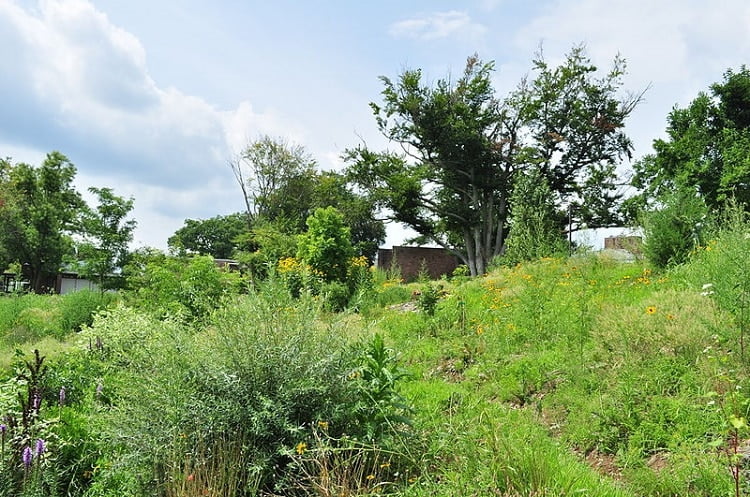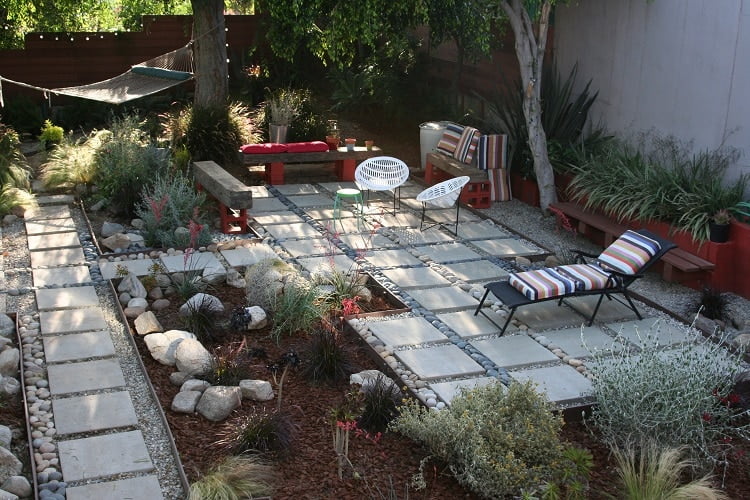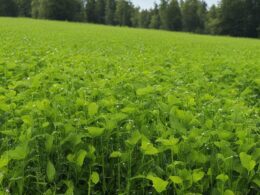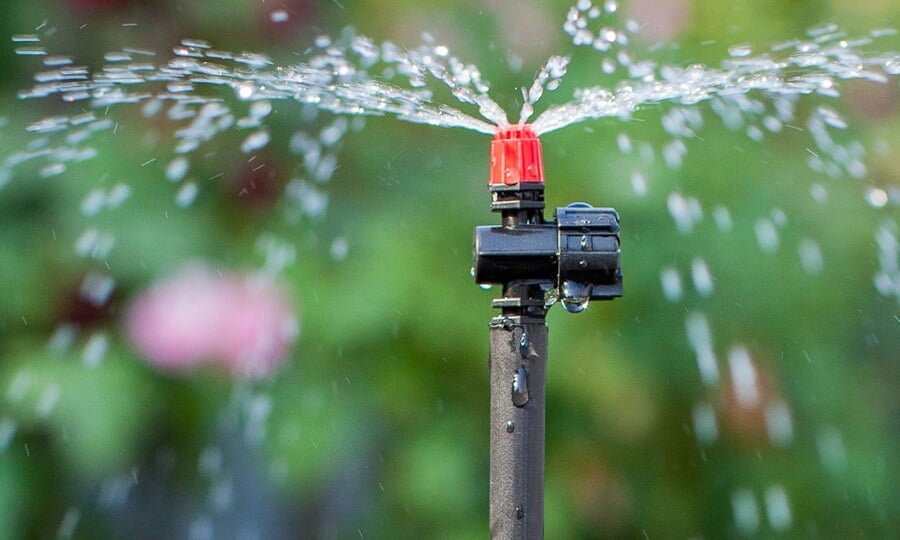Nowadays, people are more concerned about the environment than ever. Climate change has started making more and more victims, so we should find ways to protect nature and reduce its destruction. This is how sustainable landscaping arose as a trend, and as one of the biggest concerns of designers. By making your garden eco-friendly, you can contribute to saving our planet, and make a small but important change.

What is sustainable landscaping?
Through sustainable landscaping, you should analyze your use of non-renewable items in your garden, and then find ways to reduce it. This type of landscaping is eco-friendly, so it seeks to save energy, water, reduce the levels of runoff, and produce as little waste as possible. Sustainable landscaping is based on a series of principles that anyone should respect.
Principles of sustainable landscaping
The most important thing about sustainable landscaping is to regard water as a resource. Many people tend to waste water when dealing with irrigation. Therefore, this type of design values water a lot more than others, and seeks to reduce the need for irrigation. Also, it implies a smarter irrigation design, such as the use of rainwater for such systems.
Your garden’s soil is another important factor in this type of landscaping. It seeks to solve the problem of compacted soil, which prevents plants from growing or leads to erosion and runoff. Runoff, for instance, often leads to the pollution of water, thus affecting the most valuable resource.
Another important thing to keep your garden eco is to preserve all the plants growing in it. Often, people want to remove all vegetation when creating a new garden. They think this is beneficial, and helps them start afresh. However, this actually disrupts all the natural processes taking place there. You should keep all plants that are native to the space, and replace the invasive ones.
In the end, try to minimize your waste production as much as possible. This consumes a lot of energy, and might represent an important source of pollution. This is why you should consider recycling the yard and construction waste, as they can have great use in the garden.
Why should you switch to sustainable landscaping?
As mentioned above, this type of landscape design is eco-friendly. So, the most obvious benefit comes for the environment. Through sustainable landscaping, you conserve some valuable resources and help save the planet. Of course, this benefits you as well, but there’s something that you will see as a lot more helpful.
If you invest in sustainable tools and designs, you get to save a lot of money on long term. Once you install these mechanisms in your garden, they will last for a lot more than regular landscape designs. Therefore, you won’t have to spend money every year or every season on them. This also means the garden will become low maintenance. It won’t take too much effort to tend such sustainable designs.
Sustainable landscaping ideas
If you want to embrace this trend, here’s how you should get started. In fact, this is not a trend, but rather a lifestyle. Once you go green, you’ll notice all the great benefits this brings, and you won’t want to abandon your eco-friendly garden.
1. Permeable surfaces
This is a perfect idea to avoid erosion, while still allowing the soil to get all the water it needs. Whenever it rains, the soil risks producing a lot of runoff. This is both a source of pollution and a danger for your landscape, so an ideal solution would be to install a permeable surface. Gravel is one great choice, but you can also opt for sand, or some special garden paving.
These materials will allow the water to enter the ground, but will also filtrate it and prevent a big flow from reaching the drains. Apart from the ecological benefits, this choice is good from a design point of view. Permeable surfaces can offer a softer aspect to hard surfaces, and have great sensorial advantages.
2. Potted plants
If there’s not enough space for you to grow all the plants you like, there’s no need to panic. Potted plants are a good solution as well, as they still produce oxygen and attract pollinators. You can also plant herbs and vegetables in containers, and create your own edible garden in a smaller space. There’s a lot you can do with potted plants if you have a little creativity.
These options count as sustainable landscape as they bring some green elements in a space that would normally be covered in concrete. The more plants out there, the cleaner the air, so this is a big plus for the environment.

3. Rainwater collector
Since water is the most valuable resource, you should find solutions to conserve it. For this, you can install a rainwater collector that will repurpose that water no one uses. The good news here is you can get creative and use the most intricate designs you like.
You can direct this water towards your potted plants or, if you are in the mood for something more elaborate, towards the garden. Building an irrigation system from these collectors is one of the most eco things you could think of, but it’s a viable idea only in those area where it rains a lot. For more arid areas, you can keep the collectors as a side solution to watering.
4. Grasscycling
This practice is a type of recycling that helps you compost your lawn naturally. After mowing the grass, instead of throwing the clippings away, you can spread them around on the lawn. These clippings will decay immediately, and will work as compost for the lawn.
All the nutrients they contain will immediately go in the soil, thus reducing the need for fertilizer. You can also use such clippings or fallen leaves as mulch, and spread them around plants.
5. Artificial grass
This is a low-maintenance idea that will keep your garden looking good. Once you install it, you won’t have to regularly clip it or water it, so it’s a great way to save a series of valuable resources like water. You’ll also save a lot of energy you consumed when mowing the lawn, as well as fertilizer.
However, the idea of something artificial in a garden doesn’t sound too eco-friendly. This is why you should consider if you should get it installed or not. If you have to remove your natural grass, don’t do it, as you will disrupt the ecosystem. However, if there’s a barren patch of land you can save from erosion, artificial grass is an ideal choice.
6. Wildflowers
If you have a hard time with an unnatural turf, you can sow some other low-maintenance plants that will attract pollinators. Wildflowers are a great choice, since they don’t require too much attention to grow. Therefore, they will work as a great ground cover while attracting beneficial insects. However, make sure you introduce species native to your area and avoid getting some invasive plants.
7. Lawn substitute
There are plenty of ways to keep the soil moist and conserve some resources. You can easily start growing an alternative ground cover that will slowly take over your lawn. One of the most popular options is moss. Its green color will help it blend in the garden, and its natural moisture will be great for the soil. However, this might be a solution for shady spots only.
8. Leaving the meadow go natural
So far, you might have thought that sustainable landscaping is something orderly. However, if you go fully natural, you can leave plants do their thing in their chaotic style. You can make a selection of native plants in your area and add them to your garden.
As their name suggests, these plants can grow freely anywhere within your region. This means that you shouldn’t perform elaborate gardening processes to maintain them, so you get to save water and energy. Also, allowing them to grow naturally will attract pollinators, and will turn into a natural and undisturbed ecosystem. This is a huge advantage for the environment.
9. Planting drought-tolerant flowers and trees
These types of plants are used to harsh conditions, so they can live for a longer time without water. If you want to save resources without feeling guilty for killing your plants, there is the best idea for you. Succulents or trees that can survive droughts can be watered extremely rarely, but they need some other conditions to survive. For instance, these plants are not suitable for a colder region.

Summing up
These sustainable landscaping ideas bring you one step closer to saving the environment. Resources like water and energy are extremely sensitive, and overusing them can seriously affect our planet. Step by step, we can start doing more to save it, and opting for such a garden design is one of them. You will easily start saving water, energy, conserving materials, and producing as little waste as possible. In the end, your garden will be more eco-friendly without too many efforts to sustain it.
Image source: PxHere









